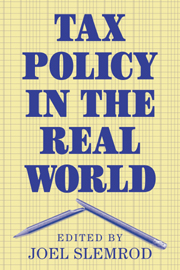Book contents
- Frontmatter
- Contents
- List of contributors
- 1 The real world of tax policy
- 2 Federal tax reform
- 3 Federalism and subfederal taxes
- 4 Principles, politics, and the professors
- Public finance in theory and practice
- On the use of ‘distribution tables’ in the tax policy process
- Taxation and economic growth
- Tax reform of the century – the Swedish experiment
- Measuring the impact of tax reform
- What is an ‘optimal’ tax system?
- How tax complexity and enforcement affect the equity and efficiency of the income tax
- Tax policy from a public choice perspective
- What is missed if we leave out collective choice in the analysis of taxation
- Public finance and public choice
- Professional opinions about tax policy: 1994 and 1934
- What can America learn from the British tax system?
- Peculiar institutions: a British perspective on tax policy in the United States
- Index
Tax reform of the century – the Swedish experiment
Published online by Cambridge University Press: 01 June 2010
- Frontmatter
- Contents
- List of contributors
- 1 The real world of tax policy
- 2 Federal tax reform
- 3 Federalism and subfederal taxes
- 4 Principles, politics, and the professors
- Public finance in theory and practice
- On the use of ‘distribution tables’ in the tax policy process
- Taxation and economic growth
- Tax reform of the century – the Swedish experiment
- Measuring the impact of tax reform
- What is an ‘optimal’ tax system?
- How tax complexity and enforcement affect the equity and efficiency of the income tax
- Tax policy from a public choice perspective
- What is missed if we leave out collective choice in the analysis of taxation
- Public finance and public choice
- Professional opinions about tax policy: 1994 and 1934
- What can America learn from the British tax system?
- Peculiar institutions: a British perspective on tax policy in the United States
- Index
Summary
Abstract - What can changes in tax structure accomplish? The Swedish tax reform of 1991 is the most far-reaching reform in any industrialized country in the postwar period. It represents a thorough application of a strategy of rate cuts cum base broadening, and it has affected a myriad of economic incentives in a more or less substantial way. This paper reviews the lessons from a major evaluation effort, sponsored by the Swedish government and involving a large number of researchers.
INTRODUCTION
Sweden might be best known as the home of film director Ingemar Bergman and—for better or for worse—as the prototype welfare state. What might be less well known is that Sweden recently implemented the most far-reaching tax reform in any western industrialized country. Although Sweden was a latecomer to the bandwagon of worldwide tax reforms of the 1980s, with the U.S. Tax Reform Act of 1986 (TRA 86) as a celebrated example, the architects of the Swedish tax reform of 1991 (TR 91) applied the strategy of rate cuts cum base broadening in an unusually thorough manner. Under the catchy slogan “tax reform of the century,” marginal income taxes were dramatically lowered and various tax shelters eliminated. According to prereform estimates, the rate cuts entailed a revenue loss on the order of six percent of gross domestic product (GDP). Measured in this way, TRA 86 stands out as a relatively modest endeavor, with a projected revenue loss of one to two percent of GDP due to rate cuts.
- Type
- Chapter
- Information
- Tax Policy in the Real World , pp. 331 - 352Publisher: Cambridge University PressPrint publication year: 1999
- 9
- Cited by



